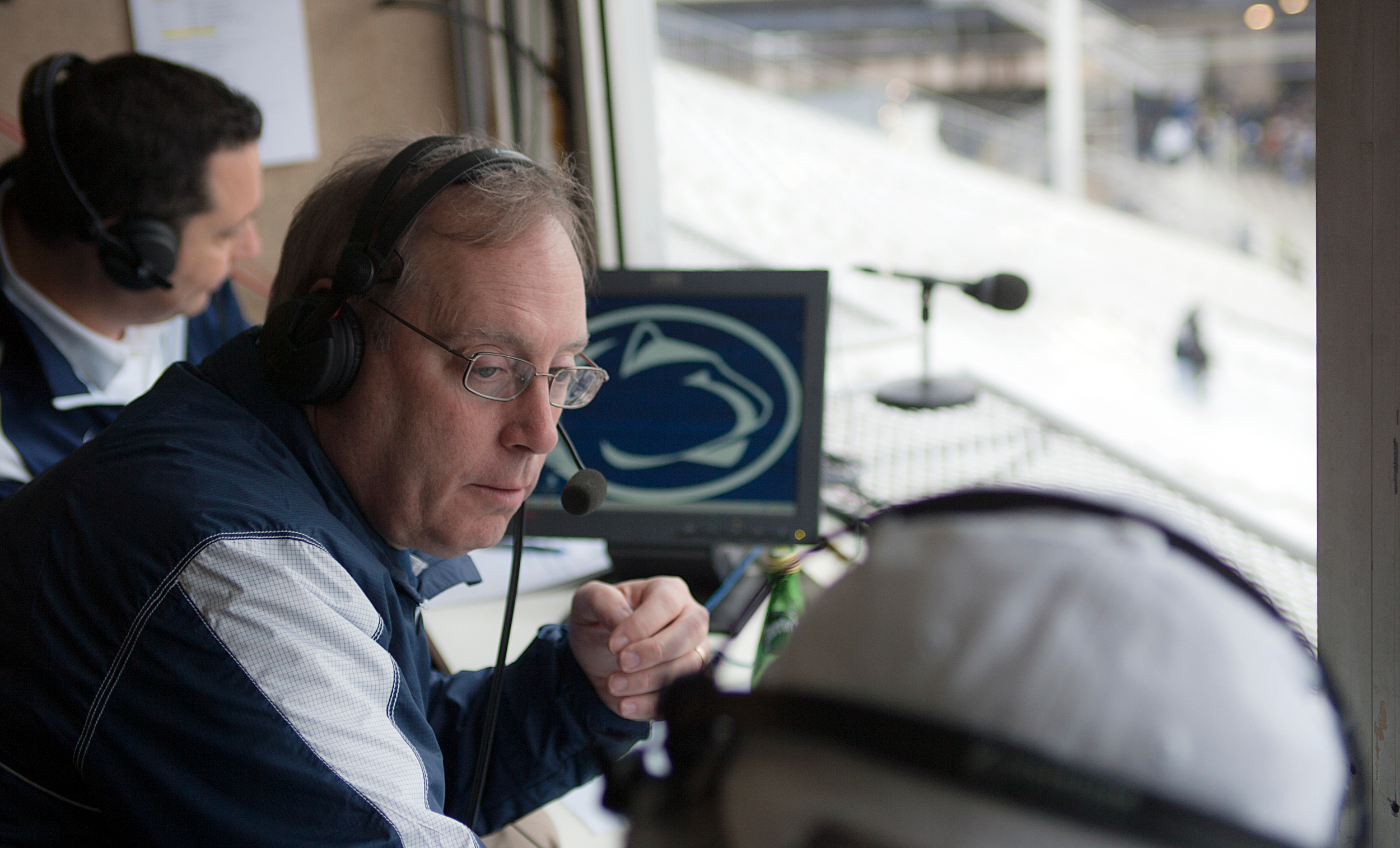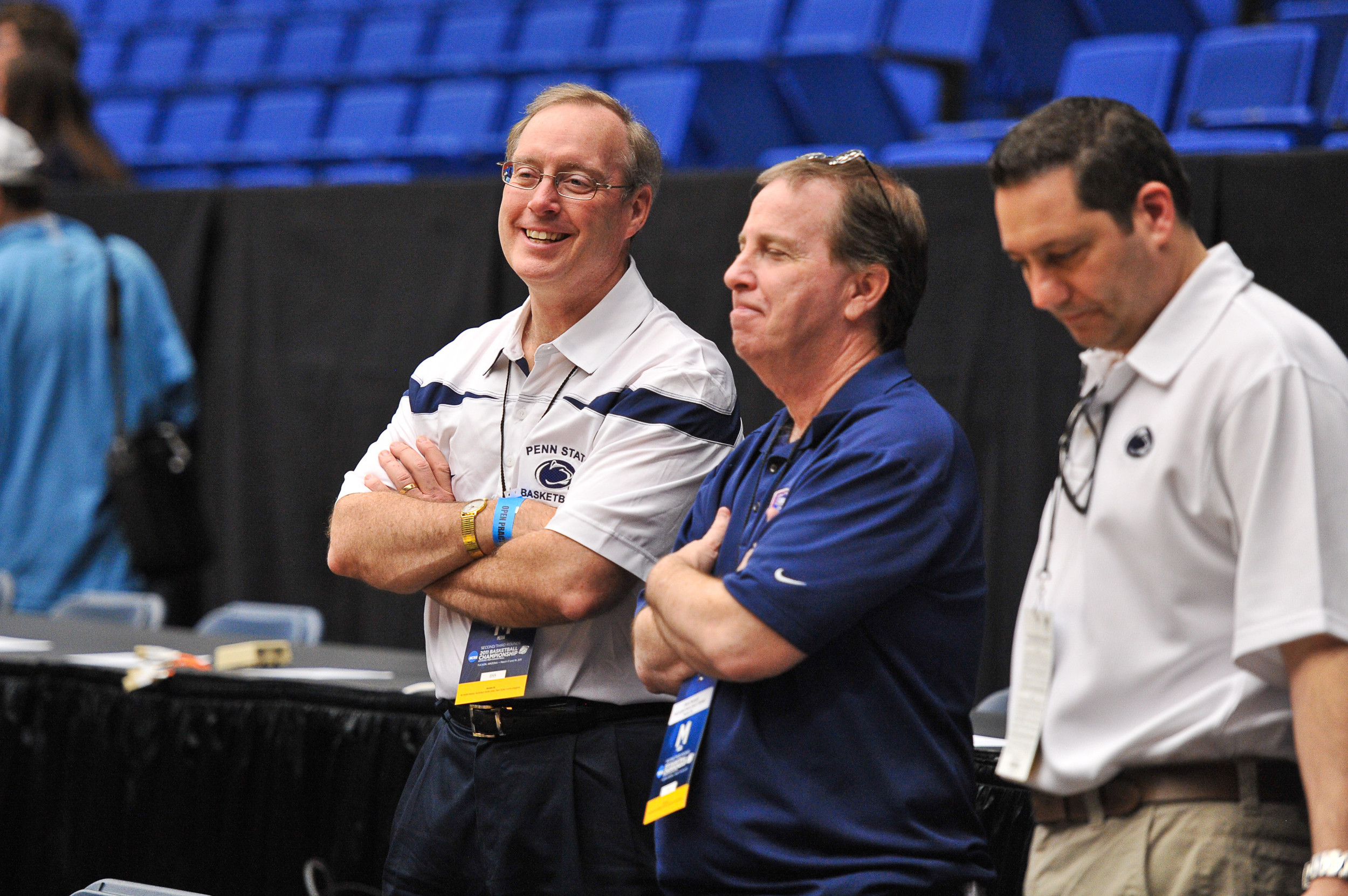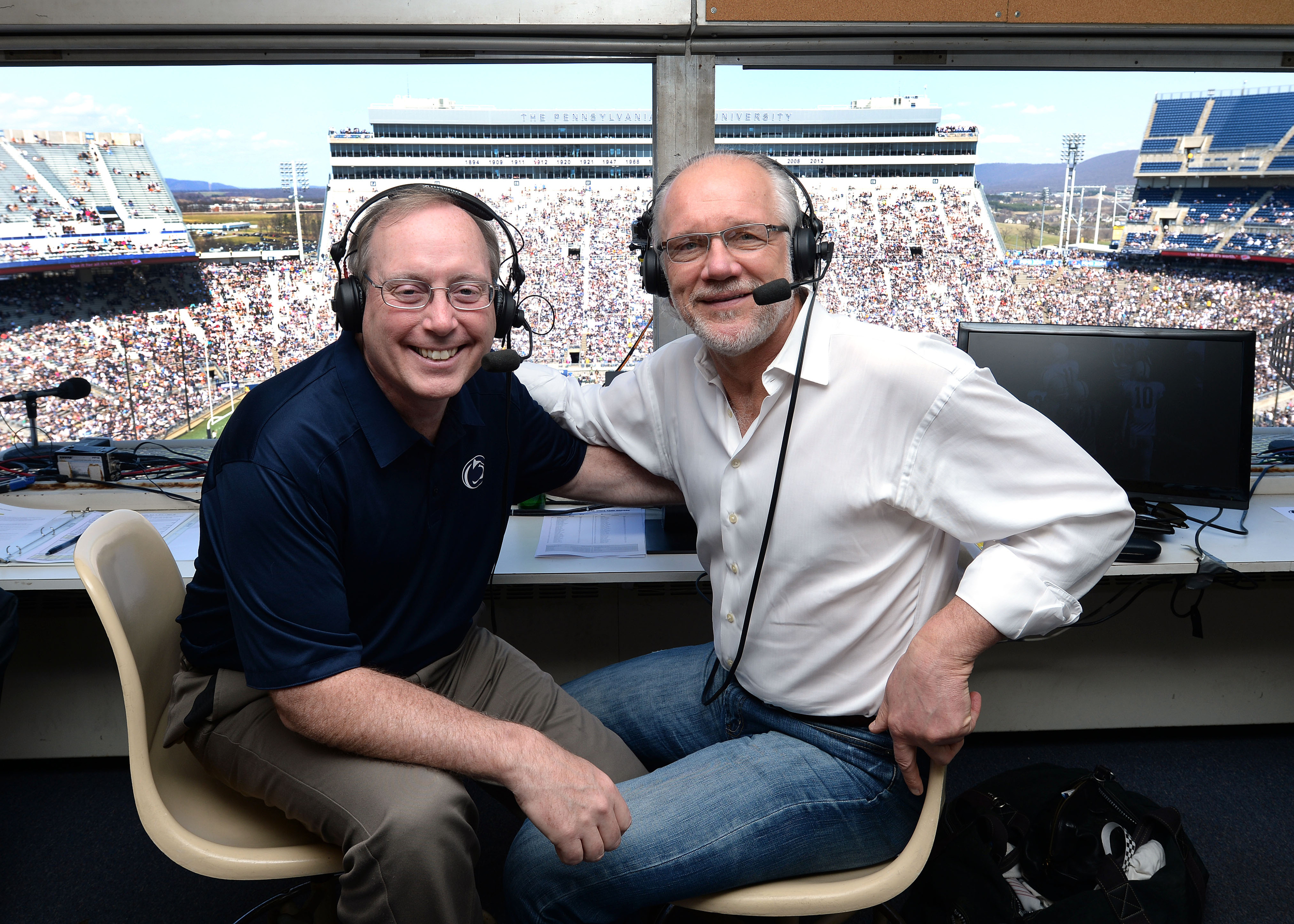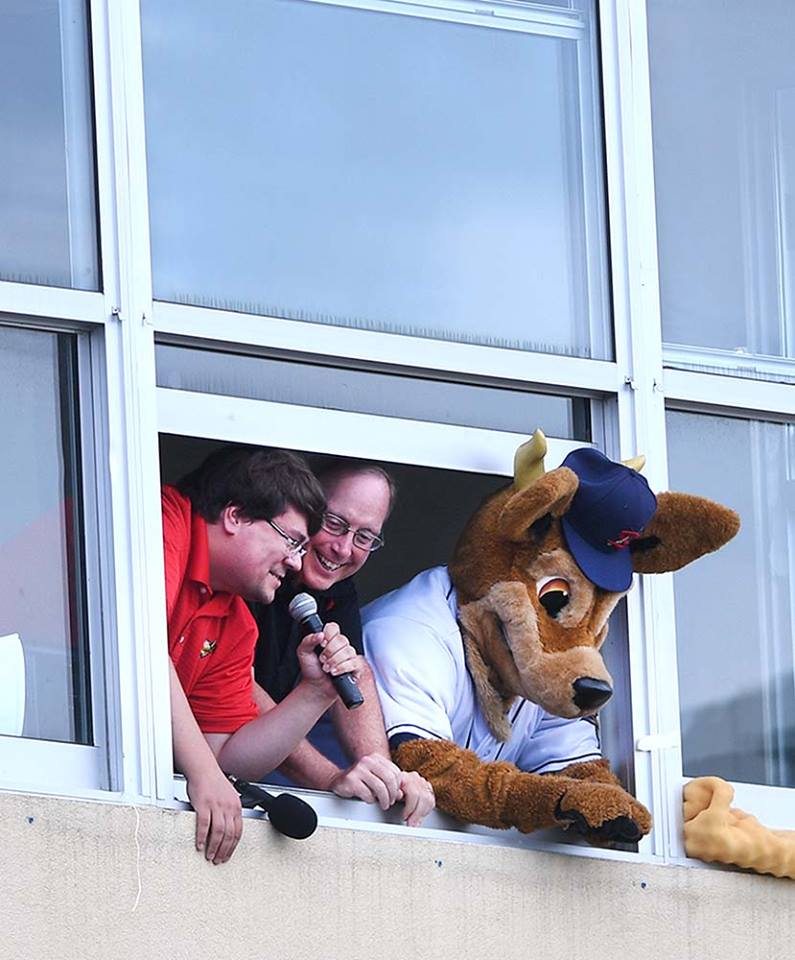“I thought, ‘Wow, what a great job,’ never once considering that you actually got paid for it.” Steve Jones
Growing up in the small town of Enfield, Connecticut, Steve Jones would sit in his room at night listening to games on the radio — baseball, basketball, hockey, football — and marvel at the announcers.
Ten-year-old Jones hung on to every word Bob Prince uttered as he announced for the Pittsburgh Pirates, absorbed every play Chuck Thompson called for the Baltimore Orioles and analyzed every piece of the game Ned Martin narrated for the Boston Red Sox — Jones’ favorite baseball team.
However, Jones never imagined someone could make a living announcing.
“I thought, ‘Wow, what a great job,’ never once considering that you actually got paid for it,” Jones said with a laugh. “I just thought it was great that you got to go to a game: ‘I would really love to try that.’”
Now, Jones lives out his childhood dream every day. He serves as the radio play-by-play voice for Penn State’s football and men’s basketball teams, having just completed his 30th season announcing football and now working his 40th season broadcasting basketball – making him the longest-serving Penn State announcer in history.

Steve Jones works from the press box in Beaver Stadium. ~ photo by Mark Selders
He attributes his success and longevity to making many mistakes announcing early on, first as a Penn State student.
“I’ve always been, it seems, in the right place at the right time,” Jones said.
When he was a kid, Jones used to visit a great uncle who worked at Penn State, managing the cow herds. Then, as now, Penn State maintained a large agriculture program.
Jones fell in love with the school – and most of all the then-46,000-seat Beaver Stadium, home of Nittany Lion football. When it came time as a high school junior to consider colleges, Jones applied to just one: Penn State.
But Jones did not get accepted into the highly competitive University Park main campus. Instead, he spent his first two years at Penn State’s Wilkes-Barre campus, before moving on to University Park.
As it turned out, this Wilkes-Barre interlude launched Jones’ career.
“They had a 10-watt radio station on the second floor of the commons. And that’s where I first started announcing and making 1,000 mistakes and then tried to somehow cut it down to 500 mistakes,” Jones said. “Then I tried to cut it down to 200 mistakes.”
Everything from stumbling to stuttering and misidentifying players happened at that branch campus station, but it all contributed to Jones finding his voice and developing his style of announcing.
Luckily, Jones said, because of the radio station’s size, no one could hear him after leaving the parking lot, so no one knew about the mistakes he made, except for himself. But that radio station no one listened to made Jones fall in love with play-by-play announcing.
After graduating from Penn State in 1980 with a degree in speech communications broadcasting, Jones began to slowly move up the ladder to his current position.
Securing a job in State College right away announcing for women’s basketball, Jones also began filling in occasionally on men’s basketball. Then, he got hired as a full-time announcer for the 1982-83 season.

Steve Jones, left, stands with Dick Jerardi and Jeff Tarman at the 2011 NCAA tournament in Tucson, Arizona. ~ photo by Mark Selders
Not long after, Penn State made Jones part of its football broadcast team as its third announcer, which he did until he became the play-by-play announcer in 2000.
Jones attributed much of his success to “two phenomenal mentors” in those early years: Gil Santos, a longtime announcer for the New England Patriots who was Penn State’s play-by-play announcer from 1983 to 1986, and John Grant, who was general manager of WPSX in State College and a color commentator on Penn State football from 1980 to 1987.
Jones said he still uses elements of how Santos made calls – the intricacies of calling a game – in his own announcing.
“For four years – I felt like I was in a moving play-by-play classroom. I was a sponge listening to everything he did, how he set up a play, how he called a play,” Jones said.
Jones said Grant taught him the value of preparation.
The preparation and the beauty of the games themselves clearly still excite Jones, and he said he feels grateful to get to describe exciting moments in Penn State history.
“I get to sit there with a blank canvas in front of me, and I get to paint the picture with words for about three to four hours,” Jones said, “every single Saturday in the fall.”
Jones said he feels fortunate to work alongside “phenomenal” coworkers who make him better at this job: his producer Roger Corey, color analyst Jack Ham and sideline analyst Brian Tripp during the football season, and color analyst Dick Jerardi during men’s basketball season.
Jones said it is important to him to have the respect of his co-workers.
“A play that’s important to me — that is not important to anybody else on the planet — that’s important to me, was the first game I worked with Jack Ham at the Meadowlands with USC,” Jones said.
During the first two-and-a-half minutes of the football game, Jones called all parts of a complicated play correctly, which won Ham’s respect, according to Jones. For that reason, Jones recalls that play fondly, as one of the most significant calls of his career.
Ham, of course, was one of the greatest football players of all time as a Hall of Fame linebacker at Penn State and with the Pittsburgh Steelers.
For over 20 years, Ham has witnessed Jones’ attention to detail in the booth.
“He puts in the time, he puts in the work, he puts in the effort… If I’d say one thing about Steve — he is so well prepared,” Ham said. “He leaves nothing to chance. And his work ethic is something very, very special.”

Jones with Jack Ham in Beaver Stadium. ~ photo by Mark Selders
At the beginning of Jones’ career, he worked upward of 70 to 80 hours a week. Even though he had to travel for games frequently, Jones said he always made time for family, wife Kathy and their five children.
He coached Little League and made sure to take family vacations.
Jones said he could not have done it without Kathy, his wife of 42 years, who was his high school sweetheart. They got married in 1979, right before Jones’ senior year of college. They now have seven grandchildren.
Jones said he now works about 50 to 55 hours a week. He’s 64 years old, and he said he enjoys every second of it.
Corey said he and Jones have “been like family” since 1984 when they first started working together at WMAJ, a State College radio station.
Corey said Jones’ passion for Penn State sports and his relationships with the coaching staffs leads to the broadcast team’s success.
“He is the voice of Penn State. It’s his life,” Corey said. “I think he lives it. I think he shows it. And I think everyone listening on the radio learns a lot about the program and enjoys Steve’s passion for his work as much as we enjoy watching and listening to him in the booth.”
Jerardi, Jones’ color analyst for men’s basketball, said Jones’ professionalism, preparation and love for the game make him “brilliant” at his job, and Jones’ “contagious enthusiasm” makes working with him one of the best parts of Jerardi’s
Not only has Tripp worked with Jones — he used to be one of his students. For years, Jones has taught the Bellisario College’s sports broadcasting class as an adjunct instructor.
Tripp said he views Jones as a great mentor.
“It’s the way he treats people, the way he treats me with respect, the way that he’s always willing to go above and beyond to lend a helping hand or advice or critique something or provide feedback,” Tripp said. “He’s just the most generous, generous guy and so supportive in so many ways.”
This year Tripp and Jones finally got to work together announcing Penn State football games. Tripp said he was thrilled to join Jones, who he said warmly welcomed him into the group and helped to fulfill on of Tripp’s broadcasting dreams.
“He is the voice of Penn State. It's his life,” Roger Corey
As a teacher, Jones said he has a very basic philosophy.
“Always the first thing I tell them is what they’re doing right,” Jones said. “Because this is the kind of business where confidence means something.”
Whether it’s compliments on a student’s pacing or voice, Jones said he tries his best to build up his students’ self-esteem to prepare them for the workforce, before offering his critiques. The goal is for students to feel like they are better than they were before they came into his class.
Another one of Jones’ former students, Zach Seyko, now co-hosts Jones’ local radio show, “Sports Talk With Steve Jones,” a show that started 10 years ago in which Jones analyzes the sports news of the day.
“What he’s done for me…is honestly very difficult to put into words,” Seyko said. “Other than the fact that he’s given me so much to go off of, to think about, to question, to challenge, to judge, to work on, to perfect and to craft. And that’s a variety of different things from prepping for a show to just how I carry myself as a personality, on and off the air.”
As if basketball, football, a radio talk show and teaching were not enough, Jones is also the play-by-play announcer for the State College Spikes, the local minor league baseball team. Since the team’s debut in 2006, Jones has called their games – and he said there is nothing like announcing a baseball game in the ballpark on a warm, summer night with the silhouettes of the mountains and Beaver Stadium in the background.
Scott Walker, the Spikes general manager, said Jones is a “true professional,” personable to every employee and fan.
“Whenever I see his prep sheets, or whatever documentation he has in front of him, it seems like he knows the ins and outs of players before I do — or even more so than I do,” Walker said. “He’ll have a profile on all the different players and he’ll know where he came from, all his stats, what he’s good at, what he’s bad at. It’s impressive to watch and listen to Steve.”
According to Tripp, Jones has an “encyclopedic memory.” He is able to remember the smallest details and facts about any sporting event, whether it’s who scored in which Super Bowl, in which quarter, with this much time left in the game.
Joe Putnam, Jones’ broadcast partner for the Spikes, said Jones’ mind is like a “steel trap,” and every piece of information Jones needs to know he will commit to memory right away. He can immediately flash back to exciting moments in whatever sport he is broadcasting.
“His voice is the soundtrack to those memories,” Putnam said. “Steve Jones is most certainly a legend in this area.”

Jones said his voice gets recognized everywhere from the line at the cash register in Wegmans grocery store to a hotel in Iowa, and after all these years he is still trying to get used to people wanting their picture with him.
Jones has announced pivotal moments for Penn State football throughout his career, including Joe Paterno’s 324th win in 2001, putting the legendary coach ahead of former Alabama coach Bear Bryant for the most wins in major-college football history. Jones also announced Paterno’s 409th win, the Penn State coach’s last, which put him ahead of former Grambling coach Eddie Robinson for the most victories by a Division I coach.
Jones said his favorite moment, however, came following a down time for Penn State football – five years after the 2011 sex abuse scandal involving former assistant coach Jerry Sandusky, which led to a host of NCAA sanctions.
By that point, James Franklin had become Penn State’s coach.
“The signature play of all … is the blocked field goal by Marcus Allen that Grant Haley picked up against Ohio State in 2016 and ran it back for a touchdown,” Jones said. “You felt that was the moment that put Penn State on the upward trajectory.”
Jones said Franklin has made him “part of the family” with the players and coaching staff over the years. He said he builds friendships with the coaches and athletes because he spends so much time with them at practices and games.
“I know what James [Franklin] is trying to do. And why. And why not. If I don’t know, I’ll ask him,” Jones said.
Jones said he realizes listeners may have different takes on his announcing.
“Oh, there are people that say, ‘He sees everything through blue and white glasses.’ I’ve had that,” Jones said. “But you know what? Ninety percent of the people who have come up to me have been all positive comments.”
Jones said he has a general rule when he’s talking about a high school or college game: He is careful to analyze the game and not criticize the players. Since the athletes are not getting paid millions of dollars like pro-athletes, Jones said it does not feel right to belabor their mistakes.
He also tries to identify every player on the field when he’s announcing, no matter how small the part in the game might be.
“The reason I do that is for the parents – and for them,” Jones said. “I’ve had parents of the walk-ons come up to me and say, ‘You know how much it meant to us that you mentioned his name?’ That’s the reason you do it, because when my parents listened to games when I played, it was a big deal to them if they mentioned my name. So, I never forgot that.”
Jones, a recreational golfer now, played football in high school – an offensive lineman. As a youngster, he played Little League baseball, basketball and ice hockey.
“I was always the kid where I was playing every sport,” he said.
Besides the good times, Jones was also witness to Penn State’s darkest moment. In 2011, he announced the first game Penn State played without Paterno on the sidelines since 1949, after the university fired Paterno in the wake of the Sandusky scandal.
“I just explained what happened that week and then said, ‘Hey, look, we’re here to announce a football game. That’s our job. Allow us to do our job today,’” Jones said. “‘And not judge excitement, lack of excitement or anything like that.’”
Jones said Penn State was able to bounce back from the scandal by hiring the “right people at the right time for the right job.” After that season ended, Bill O’Brien stepped in as head coach and helped keep the team together for the next two years, Jones said. Then after O’Brien moved on, the university brought in Franklin “with exactly the personality they needed to then take them from that point to get them to this point.”
Jones said people have approached him with other job offers several times, but he has always said no to them. He said he already has his dream career.
“Everyone has to have in their mind what they think ‘the job’ is. Now for some people in our business, ‘the job’ is to be at CBS or ‘the job’ is to be at ESPN,” Jones said. “For me, ‘the job’ has always been to me — this job.
“And so I’ve never even had even a remote feeling about going someplace else because I really felt I had the best job.”
Jones said he hopes he can keep announcing play-by-play for Penn State for many years to come.
“I’ve had the privilege of announcing some of the greatest moments in the history of Penn State football — and it is a privilege, believe me,” Jones said. “Working with James Franklin, working with the staff and being around the players. Every single day you’re around this, you feel like there’s a privilege to it.”
And his passion for sports cannot be squashed. To this day, the question Jones always gets is: which sport do you prefer?
And he always responds, “The one that’s in front of me.”
An earlier version of this story appeared in The Daily Collegian on Nov. 16, 2021.
~ 2.13.2022